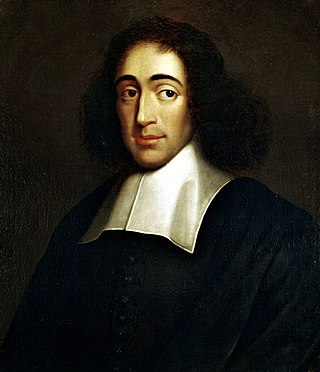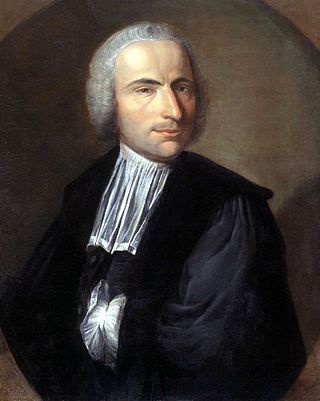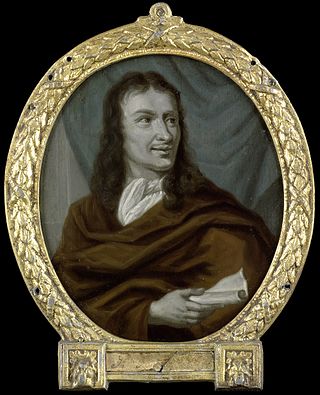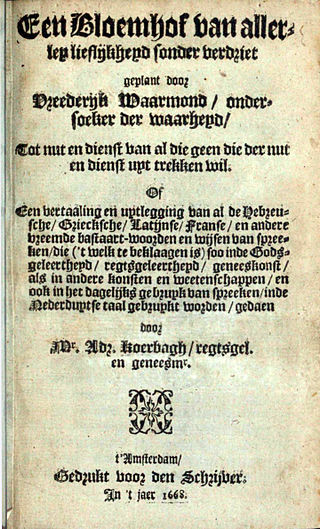Related Research Articles

Baruch (de) Spinoza, also known under his Latinized pen name Benedictus de Spinoza, was a philosopher of Portuguese-Jewish origin. A forerunner of the Age of Enlightenment, Spinoza significantly influenced modern biblical criticism, 17th-century rationalism, and Dutch intellectual culture, establishing himself as one of the most important and radical philosophers of the early modern period. Influenced by Stoicism, Thomas Hobbes, René Descartes, Ibn Tufayl, and heterodox Christians, Spinoza was a leading philosopher of the Dutch Golden Age.

Uriel da Costa was a Portuguese Sephardi philosopher who was born a New Christian but returned to Judaism, whereupon he questioned the Catholic and rabbinic orthodoxies of his time. This led him into conflict with both Christian and rabbinic institutions: his books were placed on the Index Librorum Prohibitorum and several Jewish authorities excommunicated him. His iconoclastic life culminated in suicide in c. 1640.

Leiden University is a public research university in Leiden, Netherlands. It was founded as a Protestant university in 1575 by William, Prince of Orange as the first university in the Netherlands.

The Tractatus Theologico-Politicus (TTP) or Theologico-Political Treatise, is a 1670 work of philosophy written in Latin by the Dutch philosopher Benedictus Spinoza (1632–1677). The book was one of the most important and controversial texts of the early modern period. Its aim was "to liberate the individual from bondage to superstition and ecclesiastical authority." In it, Spinoza expounds his views on contemporary Jewish and Christian religion and critically analyses the Bible, especially the Old Testament, which underlies both. He argues what the best roles for state and religion should be and concludes that a degree of democracy and freedom of speech and religion works best, such as in Amsterdam, while the state remains paramount within reason. The goal of the state is to guarantee the freedom of citizens. Religious leaders should not interfere in politics. Spinoza interrupted his writing of his magnum opus, the Ethics, to respond to the increasing intolerance in the Dutch Republic, directly challenging religious authorities and their power over freedom of thought. He published the work anonymously, in Latin, rightly anticipating harsh criticism and vigorous attempts by religious leaders and conservative secular authorities to suppress his work entirely. He halted the publication of a Dutch translation. One described it as being "Forged in hell by the apostate Jew working together with the devil". The work has been characterized as "one of the most significant events in European intellectual history", laying the groundwork for ideas about liberalism, secularism, and democracy.

JohannesHudde was a burgomaster (mayor) of Amsterdam between 1672 – 1703, a mathematician and governor of the Dutch East India Company.

Balthasar Bekker was a Dutch minister and author of philosophical and theological works. Opposing superstition, he was a key figure in the end of the witchcraft persecutions in early modern Europe. His best known work is De Betoverde Weereld (1691), or The World Bewitched (1695).
Franciscus van den Enden, in later life also known as 'Affinius' was a Flemish former Jesuit, Neo-Latin poet, physician, art dealer, philosopher, and plotter against Louis XIV of France. Born in Antwerp, where he had a truncated career as a Jesuit and an art dealer, he moved later to the Dutch Republic where he became part of a group of radical thinkers sometimes referred to as the Amsterdam Circle, who challenged prevailing views on politics and religion. He held strong ideas about education, and viewed theater as an important teaching tool. He was a Utopian planning to set up an ideal society in the Dutch colonies in America and a proponent of democracy in the administration of states. He is best known as the Latin teacher of Spinoza (1632–1677), with whom Spinoza boarded for a period. Scholars have examined Van den Enden's philosophical ideas and those of Spinoza to assess whether he influenced his pupil, Spinoza biographer Steven Nadler suggests this is not the case. Spinoza biographer Jonathan I. Israel argues that Van den Enden preceded Spinoza in writing radical philosophical texts with a combination of democratic republicanism, rejection of religious authority, and advocacy for basic equality, building on the influence of Pieter de la Court, but only after Spinoza left Amsterdam. Van den Enden was implicated in a plot against Louis XIV and executed by hanging.

Laurens Bake or Baak, Baeck was a Dutch poet of the seventeenth century.
Adriaan Koerbagh was a Dutch physician, scholar, and writer who was a critic of religion and conventional morality. He was in the circle of supporters of Baruch Spinoza.
Joan Leonardszoon Blasius was a Dutch poet, playwright, translator and lawyer. Born near Cadzand in Oostvliet, a village now lost to the North Sea, he was the younger brother of the famous doctor Gerard Blasius.

Petrus Serrarius was a millenarian theologian, writer, and also a wealthy merchant, who established himself in Amsterdam in 1630, and was active there until his death. He was born "into a well-to-do Walloon merchant family by name of Serrurier in London." He has been called "the dean of the dissident Millenarian theologians in Amsterdam".

Jean-Nicolas-Sébastien Allamand was a Swiss-born Dutch natural philosopher. He conducted early research on giraffes, using skin and bone samples sent in 1764 from South Africa.

Lodewijk Meyer was a Dutch physician, classical scholar, translator, lexicographer, and playwright. He was a radical intellectual and one of the more prominent members of the circle around the philosopher Benedictus de Spinoza.
Jacobus Wittichius (1677–1739) was a German-Dutch philosopher, a Cartesian and follower of Burchard de Volder, and holder of controversial views on the nature of God.

Pieter Verhoek, was a Dutch Golden Age poet and marble painter.

Nil volentibus arduum is a Latin expression meaning "nothing is impossible for those willing", and the name of a 17th-century Dutch literary society that tried to bring French literature to the Dutch Republic.

Een Bloemhof is a dictionary published in 1668 and written by Adriaan Koerbagh under his own name. Its full title was Een Bloemhof van allerley Lieflijkheyd sonder verdriet. The book sparked controversy in Amsterdam because of its articles defining political and religious terms, even though they comprise only a small portion of the overall dictionary. The book also offers laymen explanations for technical jargon and foreign terms, covering topics such as medicine and law.
Dutch philosophy is a broad branch of philosophy that discusses the contributions of Dutch philosophers to the discourse of Western philosophy and Renaissance philosophy. The philosophy, as its own entity, arose in the 16th and 17th centuries through the philosophical studies of Desiderius Erasmus and Baruch Spinoza. The adoption of the humanistic perspective by Erasmus, despite his Christian background, and rational but theocentric perspective expounded by Spinoza, supported each of these philosopher's works. In general, the philosophy revolved around acknowledging the reality of human self-determination and rational thought rather than focusing on traditional ideals of fatalism and virtue raised in Christianity. The roots of philosophical frameworks like the mind-body dualism and monism debate can also be traced to Dutch philosophy, which is attributed to 17th century philosopher René Descartes. Descartes was both a mathematician and philosopher during the Dutch Golden Age, despite being from the Kingdom of France. Modern Dutch philosophers like D.H. Th. Vollenhoven provided critical analyses on the dichotomy between dualism and monism.

The Epistolae are the correspondence of the Dutch philosopher Benedictus de Spinoza with a number of well-known learned men and with Spinoza's admirers, which Spinoza's followers in Amsterdam published after his death in the Opera Posthuma.
References
- ↑ Mertens, Frank (2011). "Johannes Koerbagh's Lost Album Amicorum Seen through the Eyes of Pieter de la Ruë". Lias . 38 (1). pp. 59-127, pp. 122-123, nr. 51.
- ↑ Mertens, Frank (2016). Lavaert, Sonja (ed.). The Dutch Legacy. Radical Thinkers of the 17th Century and the Enlightenment. Leiden: Brill. pp. 62–89, pp. 74–75, note 43. ISBN 978-90-04-33208-9.